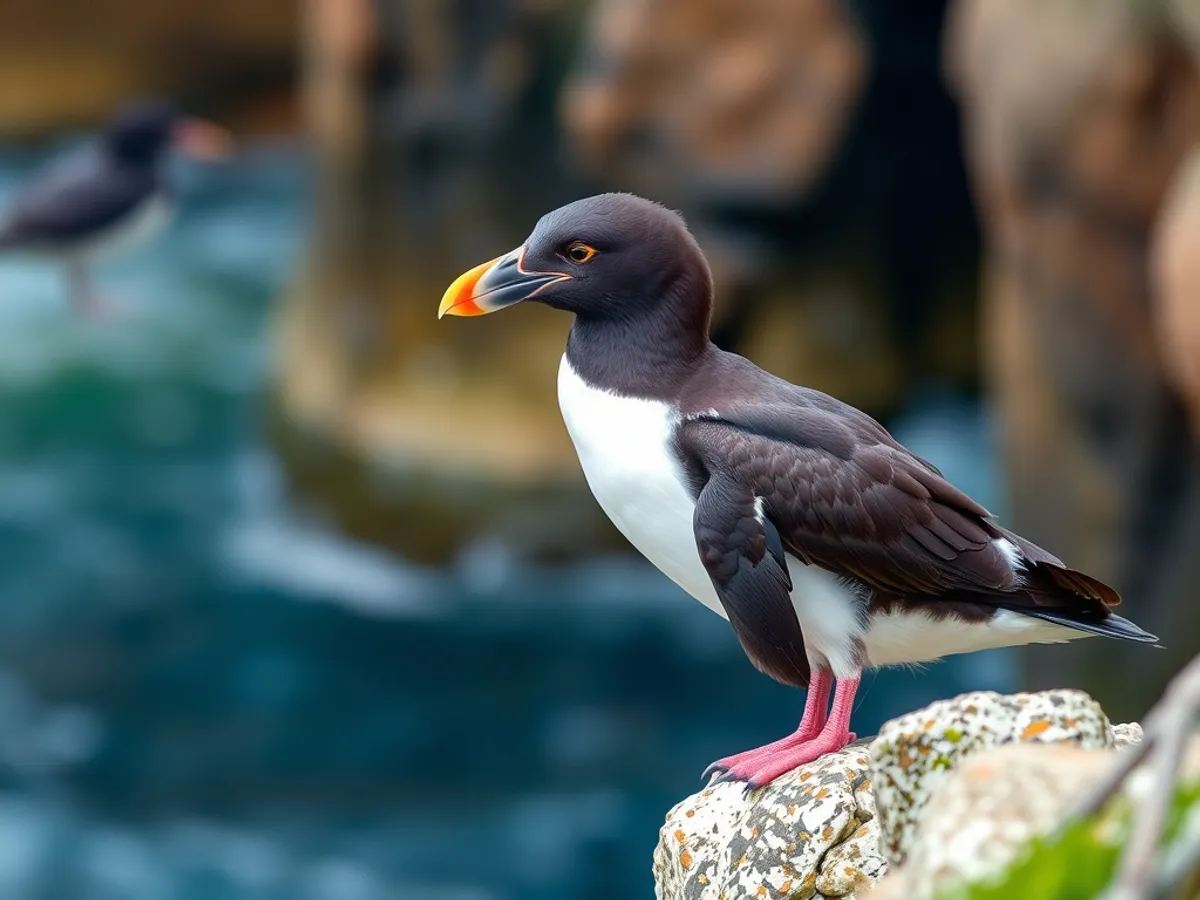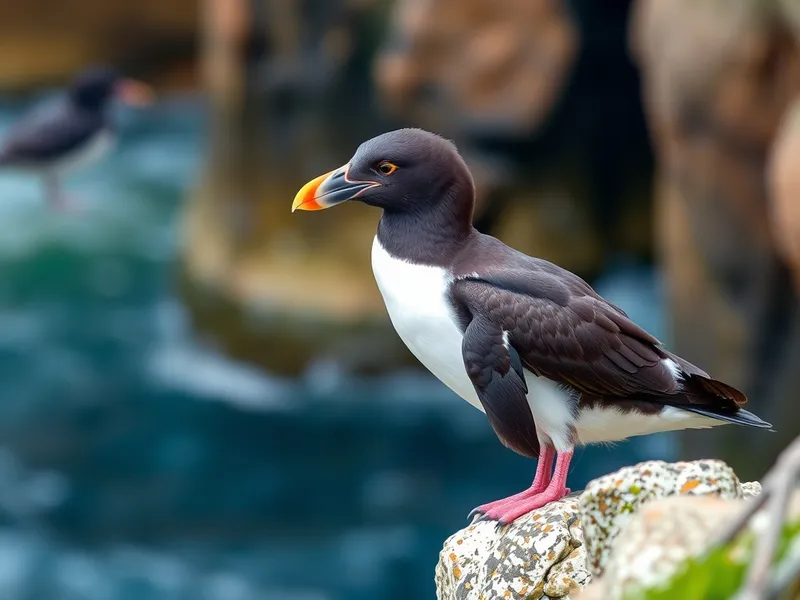
Common Murre
Uria aalge

Meet the Common Murre
The Common Murre is a medium-sized seabird known for its striking black-and-white plumage and upright, penguin-like stance. It breeds in large, dense colonies on rocky cliffs along the coasts of the North Atlantic and North Pacific Oceans. Murres are remarkable divers, capable of plunging over 100 meters underwater in pursuit of fish and other prey. Despite their somewhat awkward movement on land, they are agile swimmers and strong fliers, though takeoff requires a running start across the water.
Classification
Bird
Habitat
Coastal cliffs and open ocean
Diet
Carnivore
Lifespan
15-20 years
Conservation
Least Concern
Weight
900-1,100 grams
📖Fascinating Facts
Egg Adaptation
The unique shape of a Common Murre's egg prevents it from rolling off the narrow cliff ledges where it is laid, helping to protect the next generation.
Expert Divers
Common Murres are among the deepest diving birds, using their wings to 'fly' underwater and chase fish at impressive depths.
No Nest Needed
Instead of building nests, murres lay their single egg directly on bare rock, relying on the egg's shape and the crowded colony for safety.
📋Detailed Description
The Common Murre (Uria aalge) is a robust, medium-to-large auk, measuring 38–46 cm in length with a wingspan of 61–73 cm and weighing between 945 and 1,045 grams. Its plumage is sharply contrasting, with a blackish-brown head, neck, and upperparts, and clean white underparts. In breeding plumage, some individuals display a distinctive white 'bridled' eye-ring and line extending behind the eye. The bill is long, slender, and pointed, adapted for grasping slippery prey. Murres are highly adapted for aquatic life, with short wings that function as efficient flippers underwater, enabling pursuit dives that regularly exceed 30–60 meters, and have been recorded at depths up to 180 meters. On land, they stand upright and shuffle awkwardly due to their rear-set legs. Socially, Common Murres are extremely gregarious, forming dense colonies that can number in the hundreds of thousands, with individuals nesting shoulder-to-shoulder on narrow cliff ledges. Their vocalizations are varied, including guttural growls, croaks, and high-pitched calls, especially during breeding. The species is migratory, spending the non-breeding season dispersed over vast stretches of the northern oceans. Their diet is primarily piscivorous, but also includes crustaceans and marine invertebrates. Murres are notable for their single-egg clutch, with eggs that are highly pyriform (pointed) to prevent rolling off cliffs. Both parents participate in incubation and chick-rearing, and chicks leave the nest before they can fly, leaping from cliffs to join the male parent at sea.
💡 Did you know?
The Common Murre holds the record for the deepest dive by an auk, reaching depths of over 180 meters (590 feet) in search of food.
🔬Research & Sources
Wikipedia Summary
The common murre or common guillemot is a large auk. It has a circumpolar distribution, occurring in low-Arctic and boreal waters in the North Atlantic and North Pacific. It spends most of its time at sea, only coming to land to breed on rocky cliff shores or islands.
Last Modified: 5/23/2025
🎭Behavior & Social Structure
Common Murres are diurnal and highly social, exhibiting complex behaviors within their colonies. They forage primarily by pursuit diving, using their wings for propulsion underwater and their feet for steering. Feeding typically occurs in groups, and they may travel several kilometers from the colony to reach productive feeding grounds. Prey is captured by rapid underwater chases, and adults can carry multiple small fish crosswise in their bills. On land, murres maintain close contact with neighbors, engaging in mutual preening and frequent vocal exchanges that reinforce pair bonds and territory boundaries. Aggressive interactions, such as bill fencing and wing flapping, are common in the crowded nesting environment. During the breeding season, adults alternate between incubation shifts and foraging trips, with a highly synchronized daily rhythm. After hatching, chicks are brooded for several days before making a dramatic leap from the nesting ledge to the sea, guided by parental calls. At sea, the male parent continues to feed and protect the chick for several weeks until it becomes independent.
👶Reproduction & Life Cycle
Common Murres are monogamous, often retaining the same mate for multiple seasons. Courtship involves mutual preening, billing, and synchronized displays. The breeding season varies regionally but generally spans from May to July. Females lay a single, large, pyriform egg directly on bare rock or soil, with no nest structure. The egg's shape minimizes the risk of rolling off the narrow ledges. Incubation lasts 28–37 days and is shared equally by both parents, who alternate 1–2 day shifts. After hatching, the semi-precocial chick is brooded for 2–3 days before becoming mobile. At 16–25 days old, the chick leaves the colony in a nocturnal or crepuscular exodus, jumping from the cliff and gliding to the sea, where it is joined by the male parent. The male continues to care for and feed the chick at sea for an additional 5–8 weeks. Fledging success is strongly influenced by food availability and predation pressure.
🛡️Adaptations & Survival
The Common Murre exhibits numerous adaptations for its marine lifestyle. Its dense, waterproof plumage provides insulation in cold northern waters. The wings are relatively short and pointed, trading aerial efficiency for powerful underwater propulsion, a classic example of convergent evolution with penguins. The legs are set far back on the body, enhancing diving ability but resulting in clumsy terrestrial locomotion. The eggs' pyriform shape is a unique adaptation to nesting on narrow cliff ledges, as it causes the egg to spin in a tight circle rather than rolling off. Murres have excellent vision both above and below water, aiding in prey detection. Their high metabolic rate supports energetically demanding foraging and chick-rearing activities. Socially, dense colonial nesting offers protection from predators and facilitates information sharing about food resources.
🎨Cultural Significance
The Common Murre has played a role in the folklore and subsistence practices of northern coastal peoples. Its eggs and, less commonly, adults have been harvested for food in parts of the North Atlantic, notably the British Isles, Iceland, and Newfoundland. The dramatic cliff-jumping behavior of chicks has inspired local legends and is a popular subject for wildlife documentaries. In some cultures, murres are symbols of resilience and adaptation to harsh environments. The species has also served as an indicator of marine ecosystem health, with population trends reflecting changes in ocean productivity and fish stocks.
🔬Recent Research & Discoveries
Recent research on Common Murres has focused on the effects of climate change and marine heatwaves on breeding success and adult survival, with studies documenting mass mortality events linked to food shortages. Advances in biologging technology have revealed detailed foraging patterns, dive profiles, and migration routes, highlighting the species' reliance on specific oceanographic features. Genetic studies have clarified population structure and connectivity across the Atlantic and Pacific, informing conservation management. Long-term monitoring at major colonies provides valuable data on population trends, phenology, and responses to environmental variability. Murres are also used as bioindicators for monitoring marine pollution, including heavy metals and persistent organic pollutants.
🎥Wildlife Videos

Drama in the high arctic | Leap of faith | Thick Billed Murre
In my recent trip to Svalbard, I had the opportunity to visit the Alkefjellet bird cliffs for what I call - a BBC moment in real life. Thick ...
Life in a Blink - Art of High Speed Photography

Common Murre 바다오리 최종
Common_Murre #바다오리 #자생일 #탐조 #birding #birdwatching.
자연생태일상

Arctic Geese Chicks Jump Off Cliff to Survive | Hostile Planet
Not yet able to fly, three barnacle geese chicks must free fall hundreds of feet to reach their next meal. ➡ Subscribe: ...
National Geographic

COMMON MURRES climbing, flying, swimming Uria aalge
Uria aalge COMMON MURRES climbing, flying, swimming. huge colonies. Oregon coast, June 2018.
Rob Curtis

Common Murre Breeding Colony
Common Murre Breeding Colony, a series of short videos about what goes on within the nesting/breeding colony of the Common ...
Tim Kuhn

Arctic Birds - A Guillemot's First Flight
To enroll in this course click https://upschool.co/courses/it-starts-with-you/ Disclaimer – During this video, our guide is holding a ...
Upschool
🌍Habitat Information
The Common Murre typically inhabits Coastal cliffs and open ocean environments. Common Murres have adapted to their environments with specialized features and behaviors.
Primary Habitat:
Coastal cliffs and open ocean
More detailed habitat information will be available soon.
🛡️Conservation Status
The Common Murre is currently classified as Least Concern. Conservation efforts are crucial for preserving this species for future generations.
Common Threats:
- 🏠Habitat loss and fragmentation
- 🌡️Climate change impacts
- 🎯Hunting and poaching
- 🏭Human-wildlife conflict
⚠️Threats & Conservation Challenges
While currently assessed as Least Concern by the IUCN, Common Murres face several threats. Oil spills and chronic marine pollution can cause mass mortality through plumage fouling and ingestion of toxins. Overfishing of key prey species, such as capelin and sand lance, can lead to food shortages and breeding failures. Climate change is altering marine ecosystems, shifting prey distributions and increasing the frequency of extreme weather events, which can impact chick survival. Bycatch in fishing gear, particularly gillnets, poses a significant threat in some regions. Human disturbance at breeding colonies, egg harvesting, and introduced predators (e.g., rats, foxes) can also reduce reproductive success. Despite these challenges, many populations remain stable or are recovering in areas with effective conservation measures.
🔬Scientific Classification
Scientific Name
Uria aalge
Classification Hierarchy
🔍 About Taxonomic Classification
Taxonomic classification is a hierarchical system used by scientists to classify and organize living organisms based on shared characteristics and evolutionary relationships.
The system moves from broad categories (Kingdom) to increasingly specific ones, with each animal's scientific name typically consisting of its Genus and species.
📝Community Notes
Share your observations and insights about the Common Murre with our community of wildlife enthusiasts.
Join Our Community
Sign in to share your observations and connect with fellow wildlife enthusiasts.
Sign In to ContributeNo community notes yet
Be the first to share your observations about the Common Murre!
Explore Common Murre
Select a tab above to learn more about this amazing animal.
📸Photo Gallery
No photos available for this animal yet.
🌟Discover More Wildlife
Continue your journey of discovery with more fascinating animals from our database
